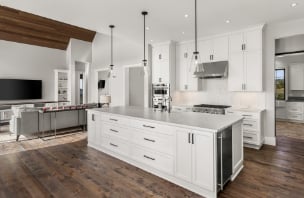The number of times you can refinish a hardwood floor is not unlimited. In general, solid boards can endure more refinishes than engineered hardwood flooring, which may only withstand one or two sanding jobs.
When sanding any floor, the amount of wood you remove depends on the coarseness of the paper you use. Flooring professionals can sand away as much as 1/16 inches of wood with the coarsest paper. However, some engineered floors cannot sustain more than one heavy-duty sanding, as they may have a surface veneer of only twice that thickness. Refinishing these floors more than once poses a risk of wear-through.
Solid boards that have a 1/4- to 5/16-inch covering over the nails and a 3/4-inch-thick body can sustain, on average, up to 10 minor sanding jobs that mostly affect the finish or four major reworks that remove more substantial amounts of material.
How Often to Refinish Hardwood Floors: The Cross-Section Test
Figuring out how many times you can refinish your floor — or if it should be refinished in the first place — can be done using the cross-section test.
If your floorboards are solid, try measuring their total thickness with a ruler. The risk is high if the boards measure any less than 9/16-inch thick. In the case of engineered flooring, refinishing is risky if the boards have a veneer measuring less than 3/32 inch in thickness.
Should You Refinish or Replace a Wood Floor?
After considering if refinishing your floors is the right choice, you’re likely to wonder if a total replacement is in order.
Refinishing your floor may extend its life, but at some point, repairs will be necessary. While replacing your hardwood floors costs more than refinishing them, there are some benefits to opting for a reinstallation.
A floor replacement means you’ll have entirely new wood with a long life ahead of it, as well as the opportunity to change the type or color of the wood to your liking. You can also opt for wood tiling or other flooring materials instead of wood.
Reasons to Refinish
If maintained properly, wood flooring can last for a good 20 to 30 years. Reasons to refinish your floor over opting for a total replacement include:
- Noticeable irregularities: Sunlight can alter floorboards’ color, so you may want to address these irregularities without replacing the wood.
- One or two isolated boards are scratched: You can have individual panels replaced if they have deep gouges penetrating the bare wood.
- Flooring looks unappealing, dry or old: You may want to restore the shine and color of your floorboards so that they no longer show their age.
Reasons to Replace
You may want to replace your hardwood floor if:
- You notice curves, bends or warping: Warping occurs when floorboards are exposed to humidity or moisture — these cases warrant full replacements.
- The wood is severely worn down: The flooring you own could have been refinished so often that the boards are thin or faded.
- It’s past its prime: If your floor has been in use for over three decades, it may simply be past its prime.
- You’re craving something new: You may want to install a new floor entirely, like stone or tile, to suit a renovation or change in décor.
Find Flooring Solutions at 50Floor
Although floor replacements are less common than refinishing a wood floor, there are certainly times when a complete replacement is warranted. If you’d like some help deciding what’s best for your home, reach out to the professionals at 50Floor today.
When it comes to functionality and aesthetics, we know how important your floors are to the overall look of your home. That’s why we offer a shop-at-home experience for a variety of flooring styles. Whether you want new carpet, vinyl, laminate or another option, we have the floor style for you, and we’ll bring samples so you can experience it in your own environment.
Contact us online or schedule an appointment to discuss refinishing or replacing your floor with our professional services.



